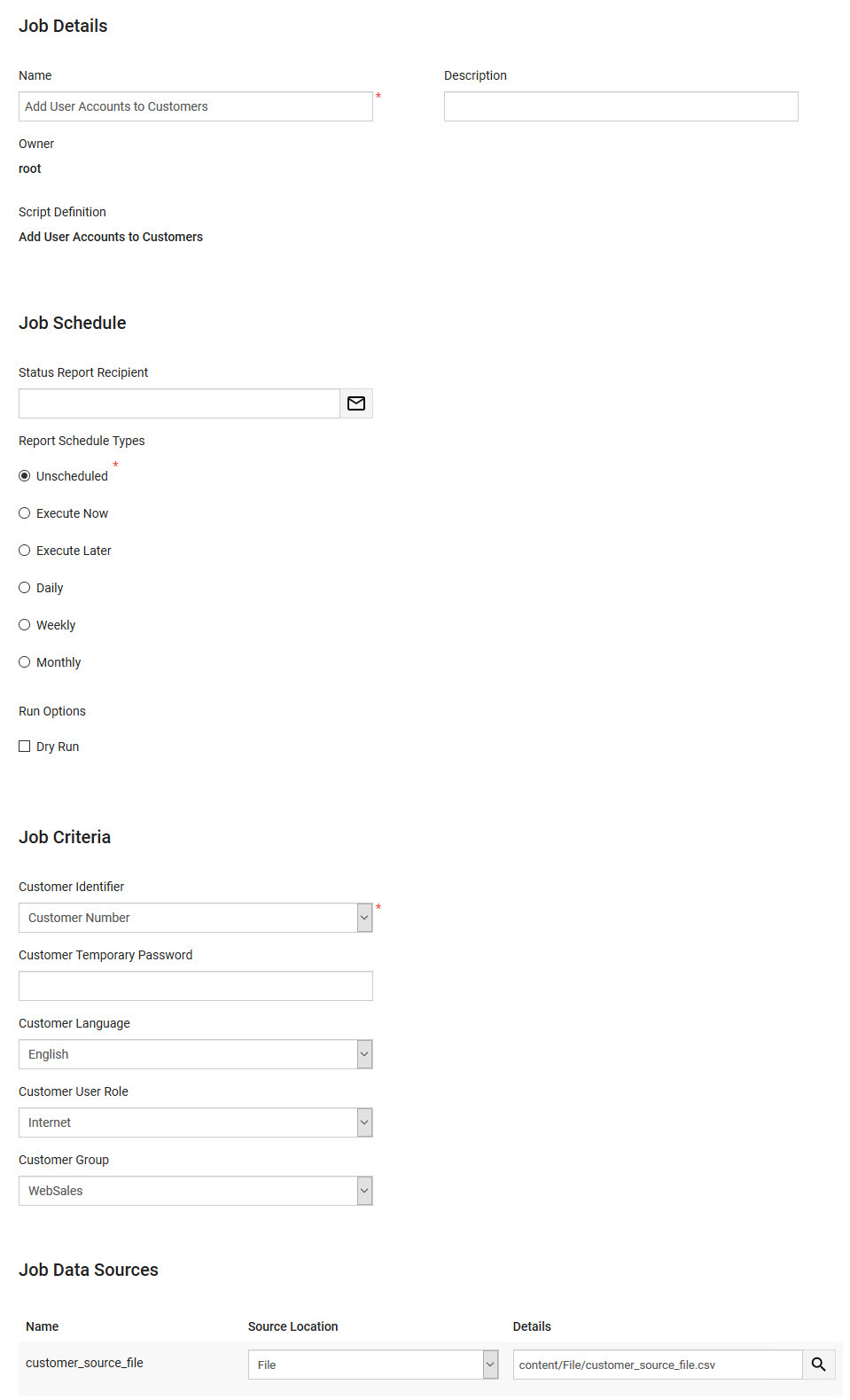•Creating and Executing the Data Management Job
•Data Management Configuration
Summary
Script Name |
Add User Accounts to Customers |
|
Minimum Supported Version |
7.17.0 |
|
Source Type |
Single Source |
|
Script Definitions |
Add User Accounts to Customers |
|
Use Case
The Add User Accounts to Customers script adds online users to existing customers.
Configuration Prerequisites
If fields referenced in the script do not have 'Writable' set to Yes, the script will still run successfully but those fields will not be updated. The following table lists the required field configuration for this script to run properly. For more information, refer to Configuring Marketing Data Fields.
Source File Format
This script is run using a single .CSV or BI (saved as a text/csv 'Extract Tempate') source file.
The customer_source_file source file is used with the Add User Accounts to Customers script:

Column |
Required? |
Source Column Header |
Field Name |
UI Field Location |
1 |
Yes |
customer |
'Customer Number' / 'Legacy Account Number [1-3]' (Used as a Source Key Column) |
Customer Services - Customer|Basic page |
2 |
Yes |
user_name |
Username |
Customer Services - Customer|User page |
3 |
No (password must be provided in the source file or the script job's execution fields) |
password |
Password |
Customer Services - Customer|User page |
How the Script Works
The following table outlines the actions and expected results the script:
Condition |
Action |
Expected Results |
The 'Customer', 'Username' and 'Password' fields are provided with accurate information. |
The script will add usernames and passwords to the customers for the role and group provided |
'Username' is added to the customer. |
The password column is blank or missing. |
The script will add username with the password provided in script job and all of the users will be created with same temporary password. |
All users will have the same temporary password. |
The 'Customer Identifier' execution field is used to define which value is used to search for the customer (either 'Customer Number', 'Customer ID' or one of the 'Legacy Account Number [1-3]' fields). |
The value selected in the 'Customer Identified' execution field will define what customer should be provided in the customer_source_file. |
If the 'Customer Identified' execution field has the value Legacy Account Number 2 selected then the customer values provided in the source file are assumed to be 'Legacy Account Number 2'. The membership will be added to all of the customers that match the provided 'Legacy Account Number 2' value. |
Creating and Executing the Data Management Job
Script Definition Configuration
The following tables outline the script definition configuration:
•Script Definition Name: Add User Accounts to Customers
•Application Script: Add User Accounts to Customers (text/plain)
Source Section |
||||
Source Name |
Source Type |
Source Key Column |
Parent Source Name |
Parent Key Column |
customer_source_file |
Comma Separated Values |
customer |
None |
None |
Execution Field Section |
||
Row |
Field |
Source Key Column |
1 |
Customer Temporary Password |
Name: customer_password Label: Customer Temporary Password Type: String Subtype: None List: None Max # Values: 1 Default Value: None Group: None Display on New Row: Yes Required: No |
2 |
Customer Identifier |
Any value from the customer identifiers list can be used, based on the values in the source file to identify a customer uniquely. The default value is set to Customer Number. |
3 |
Customer Language |
Name: language Label: Customer Language Type: String Subtype: None List: language Max # Values: 1 Default Value: English Group: None Display on New Row: Yes Required: No |
4 |
Customer User Role |
Name: user_role Label: Customer User Role Type: String Subtype: None List: Roles Max # Values: 1 Default Value: Internet Group: None Display on New Row: Yes Required: No |
5 |
Customer Group |
Name: user_group Label: Customer Group Type: String Subtype: None List: Groups Max # Values: 1 Default Value: WebSales Group: None Display on New Row: Yes Required: No |
Data Management Configuration
The following outlines the data management job configuration:
•Data Management Job Name: Add User Accounts to Customers
•Script Definition: Add User Accounts to Customers (text/html)
The following image is an example of the Data Management|Schedule page when creating a job using all of the available source files:
